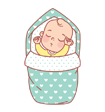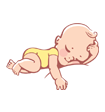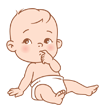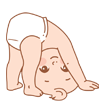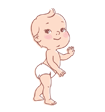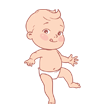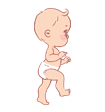Your Newborn Baby
There is no bond stronger than that of a mum and her newborn. This bond starts the moment a mum holds her baby next to her chest, and the baby feels their mum’s warmth and hears her heartbeat. This experience boosts the little baby's immunity. Babies are given breastmilk within the first 1/2 hour after birth. After that, they are breastfed according to their needs. Your little infant has stored up energy and nutrition within themselves to provide their bodies energy up to two days after birth.
Some facts about your newborn
- Their skin is pink.
- The circumference of their head is between 33-35 cm.
- They are around 50 cm in length and weigh close to 3 kg.
- Their breathing rate is 30-40 times per minute (shallow, short breaths at the beginning).
- Their temperature will range between 36.4-37 degrees Celsius.
- Their abdomen looks inflamed.
- Their hands and feet are well rounded and warm.
- Their eyes remain dry, with no tearing during the first stages. The white area of the eye is slightly blue.
- Their heart rate will range between 120-140 beats per minute.
- The remaining part of the umbilical cord will be dry. This will start to wither and shrink after 3-4 days and eventually fall off after 7-9 days.
- Waxy substances (Vernix caseosa, also known as vernix) are present on the baby's skin. This is a protective layer that acts as a disinfectant.
Vaccination
The BCG vaccine needs to be administered to the left upper arm within 24 hours of birth. This vaccine helps control tuberculosis. If a scar does not appear after some time, the vaccine needs to be repeated after 6 months.
First blood test
During the first 24-48 hours at the hospital, blood is taken to check the functioning of the baby's thyroid gland (TSH test). This is important because around one in every 3,000 babies can become infected with the disease, and early diagnosis can result in treatment that can almost completely cure it.
Things to pay attention to after you go home
- Your baby should urinate at least eight times a day.
- The newborn should pass stools once or twice a day. There are some infants who may be constipated and not let out motion for up to seven days. Both cases are normal. Mothers should not worry if their baby’s stool is not set or thick. There are some babies that let out stools every time they feed!
- You need to nurse your little one for 25-minute sessions every two to three hours. Nursing time can vary with the growth of the baby. Some children suck their required amount of milk in five to ten minutes.
- Eight nursing sessions a day should be enough.
Taking care of the umbilical cord
- Keep it dry and clean.
- Do not apply spirits or any other substance.
- It should fall off after about seven days, but in some cases, it can even take up to four weeks. As this drops off, you might notice a few drops of blood.
- It is important to consult a doctor if there is excessive bleeding, redness and swelling around the umbilical cord.
Childcare and safety
- Protect your child from extreme cold and heat.
- Dress your child in cotton.
- Bathe the infant daily with slightly warm water.
- Make sure you wash and dry the baby’s underarms.
- Limit touching your infant, except when washing.
How your little one will behave in their early days
These changes are natural and do not require medical attention.
- Frequent sneezing.
- Runny nose.
- Frequent hiccups.
- Frequent squirming and straining.
- Staying active but letting out little cries occasionally.
- Crying a lot in the evening.
- Crying loudly when urinating or letting out motion.
- Sleeping for 16-18 hours a day.
- Reddish spots on the skin (these spots could appear after 2-3 days of birth, but then disappear after some time. They will be easy to notice. A small lump may be detected when you touch the red area. If you press hard, the red colour might fade away but reappear once you let go).
Physical growth
You should not expect your baby to gain weight within the first 10 days after birth. However, after this initial period, they should start gaining weight. Typically, weight gain after 10 days will be around 25-30 g a day. After a month, their weight should have increased by up to 500-600 g.
- By the end of the first month, the baby's ability to pay attention will increase and they will start to respond.
- Co-ordinates with a substance on the face.
- They will start putting their hand inside their mouth.
- After one week, the baby will start to recognize their mother’s face.
- They will only recognize colours such as black, grey, and white during the first month.
- Although their hearing is not fully developed, they will start to recognize their mother’s voice during the first month.
- Their taste perception will improve and they will be able to identify sweetness and bitterness.
- It is normal for a boy's testicles or a girl's genital areas to swell. In girls, vaginal bleeding may occur. This is because the mother's hormones are still present in the baby.
- They will start looking into the light and staring into faces.
Development needs of the child
- Cultivate bonding between you and the newborn through close eye contact.
- Smile a lot with your baby (how can you not?).
- Spend time singing and telling stories to your little one (they love to hear your voice even though they might not understand anything yet!).
- Play with your baby.
- Massage your baby (who doesn’t love a good massage?).
- Never shake your baby. At times, this can lead to bleeding in the brains of children.
Article by Mrs. Krishanthi Ganga Kumarihami, Midwifery Nurse (Grade 1) at Kurunegala Provincial General Hospital.
Your Little One First Month
Your little one will be quite the noisemaker now (hint - lots of crying and drama ahead!). This is a normal part of their development. These behaviours can vary from child to child and can last for approximately three months. Doctors advise that you feed breast milk only during these times they fuss.
Activities
Now your little one has the ability to keep their head straight for a few moments as you hold them upright. Your bundle of joy will try their best to express their delight whenever they make eye contact with you. Take your time to provide maximum support as they take baby steps in improving their communication skills.
Eyesight and movement
Your little one’s eyesight has improved after a month’s growth. Now they are able to see an item from about 45 cm away. They can see moving objects too and move their eyes from side to side and top to bottom. They will start to pay attention to voices and look at you whenever you speak. They might vocalise sounds such as "aa, o". Your infant will be interested in movement and will turn their head from side to side as you move about. They might be able to lift up their chest area. The infant now recognizes that they have hands and palms. If you keep something on their open palms they will be quick to grasp at it. They will also open their mouths when they see your breasts or the milk bottle. Pay attention mum, you might even see your little one raise their heads just a bit during tummy time!
Weight, length and saliva production
A one-month-old boy will weigh around 5.5 kg, and their length will be 23 inches. Girls this age will weigh about 5 kg. During this time, the baby's glands will produce excessive saliva. Since your little one hasn’t developed their swallowing skills, most of this saliva will flow out! This can last up to two years.
Keeping tabs on growth indicators
It is good to keep up to date about what your child’s level of growth should be each month. But never compare your little one with other babies of the same age. Each little one will develop at their own pace so do not worry if your baby is yet to show some growth signs we mentioned earlier. If you are worried, always seek the advice of a doctor.
What you can do to help your child's development
- Make sure you have lots of eye contact every time you breastfeed.
- Talk to or sing lullabies to your child during breastfeeding.
- Caress your child lovingly.
- When your child cries, embrace them and show your love.
- Do tummy time to help them strengthen their necks.
- Encourage your child to laugh and respond with a smile whenever they smile.
- Place brightly lit toys with music over their bed or cot and see how your little one’s eyes try to follow their movements.
Article by Mrs. Krishanthi Ganga Kumarihami, Midwifery Nurse (Grade 1) at Kurunegala Provincial General Hospital.
Your Bundle of Joy is 2 Months!
Your baby who is still breastfeeding, is now trying to learn how to control their body. This most likely means that they can hold their head upright while lying down. Your baby has now become an expert in sucking milk. They have also learnt to play alone and have fun, which has many developmental benefits.
Your baby by now recognizes your (mother's) precious voice and the bond between you is growing stronger each day. Their eyes will follow yours, and they will smile and laugh with you. They will also closely observe their toys, and their heads will move wherever their toys move. However, expect more loud crying and hassling. This is the age they will experiment with multiple forms of communication with their mum. E.g: crying when hungry.
Activities to look out for:
- Communication of emotions through facial expressions (frustration, interest, depression)
- Attempted communication through body movements.
- Sounding out ‘coo’.
- Putting both hands together, stretching and folding their hands and feet.
- Raising their head and chest while lying on their tummy.
- Playing with their hands, and interlocking fingers
- Stretching out a hand towards an object and holding it with their full palm.
- Turning their head when they hear a sound.
What you can do to help your baby's development:
- Smile with your baby. When the baby smiles at you, the body's natural chemicals are secreted, which helps the body to feel safe and secure. This helps the child develop.
- Hug and kiss the baby. Sing softly so that they can hear you (they are your number one fan!). This will help the child become familiar with the sounds and words, which will go a long way in helping to improve their language and communication skills.
- Spend time playing with them - playtime is growth time! It helps brain development and children learn a lot about the world through play. This also helps develop a strong mother-child relationship.
- Do tummy time at least 1 - 5 minutes every day. These activities strengthen the head, neck and upper parts of the body and will teach your baby how to kneel down and stand up faster.
- Massage the baby – this will improve their relationship with you.
- Learn to recognize the emotions of your child through their facial expressions. When you become an expert you will be able to correctly identify why your little one is crying most of the time. After all, when a child ends up crying a lot they can become stressed and depressed.
- Play with bright balls, and roll them around, so that your baby’s eyes and heads learn to track their movement. This will help strengthen your baby’s neck muscles.
Vaccinations
Make sure to get your baby vaccinated with the Triple injection when they are two months old. This covers three key illnesses – Diphteria, Tetanus and Pertussis (whooping cough).
Article by Mrs. Krishanthi Ganga Kumarihami, Midwifery Nurse (Grade 1) at Kurunegala Provincial General Hospital.
The Third Month of Your Little One
Breast milk should continue to be the one and only source of nutrition for your baby. This is medically endorsed and recommended. There may be some children who are given other types of milk such as soy milk or milk powder, but this option is only considered if there are any complications and based on medical advice.
The little one can now clearly identify your voice and their bond with you is growing leaps and bounds! They love to look into your beautiful eyes, smile with you and maintain various forms of communication. However, crying remains the only way that they can communicate. There will be no big difference in height compared to the previous month. At birth, the average height of infants is around 50 cm and by the end of 1st year it is 75 cm. Weight increases by about
500-600 g.
Activities to look out for:
- Turns head towards bright colours and lights.
- Moves eyes towards sounds.
- Newfound ability to clench their fists.
- More control over both hands and feet. Did we mention they love to kick?
- Taking initial steps towards hand-eye coordination by attempting to:
- Brings clenched fists to touch mum, pushing using hands and feet, opening arms.
- Raises (or tries to raise) head and chest by pushing using elbows.
- Inherits an adorable smile and loves to hold a gaze with others for longer times.
- Starts to cry when tired or uncomfortable. Starts to smile and make gurgling noise when happy or excited.
What you can do to help your baby's development:
- Your little baby loves to look at your face. They are stimulated when you bring your face closer to their face and catch their gaze. Try and also mount a mirror to the cradle so your infant can see themselves.
Article by Mrs. Krishanthi Ganga Kumarihami, Midwifery Nurse (Grade 1) at Kurunegala Provincial General Hospital.
The Fourth Month of Your Little One
Breast milk should still be the one and only source of nutrition for your little one.There may be some children who are given other types of milk such as soy milk and milk powder, but this option should only be considered if there are any complications and be based on medical advice.
By this month, your little one will start having about two short naps a day. In total, an infant this age requires 14 to 16 hours of sleep per day, which includes the long night-time sleep of 7-8 hours as well as day time naps. By the 4th month, your Baby girl weighs 10-19 pounds and her length/height will be around 22-26.5 inches. If yours is a baby boy, he will weigh about 11-20 pounds and his length/height will be around 23-27 inches.
Activities to look out for:
- Lifts head up.
- Starts holding their feet using hands when laying on their back.
- Starts putting anything and everything their hands grasp inside their mouth.
- Will try to sit using their hips and lower back movement, with your loving help.
- Naturally smiles with everyone.
- Identifies family members.
- Smiles when they see themselves in the mirror.
- Love to play! Cries when you stop.
- Turns around to look if something falls.
- Uses both hand movements and facial expressions to communicate.
- Tries to communicate with parents through vowel sounds such as ‘oob, aab, coo’.
- Loves to drop things and waits eagerly for you to pick it up, just so that they can drop it again and again!
- Sharper sight helps them see across the room now.
- Identifies the colour red.
Vaccinations
- It’s time to give your baby the Penta vaccine and polio oral vaccinations.
This helps prevents diseases like tuberculosis, whooping cough, hepatitis B, diphtheria, Haemophilus, influenza, and polio.
What you can do to help your baby's development:
- As your baby is trying to explore and learn, start to introduce new toys.
- Spend a few minutes reading a book with them and singing every day.
- Encourage play that trains their the eyes and engages the entire body.
- Play with your child in front of the mirror.
Article by Mrs. Krishanthi Ganga Kumarihami, Midwifery Nurse (Grade 1) at Kurunegala Provincial General Hospital.
The Fifth Month of Your Little One
Your little one is growing up fast but still, breast milk should remain the one and only source of nutrition for your little one. General medical advice recommends breast milk should be the only source of nutrition for your little one until they complete 180 days. If you have to return to work or there is a complication, you could, only after obtaining advice from your doctor, introduce alternative sources of nutrition. However, if you are a stay-at-home mother that is producing sufficient milk, you should continue breastfeeding until the first 6 months are completed. If you’re planning on introducing additional food for your five-month-old baby, you can find helpful information in our post titled ‘The Sixth Month of Your Little One’.
Your baby will generally sleep around 10-12 hours a day. This includes the duration of their three to four daytime naps. At 5-6 months, the average weight of a baby boy or girl is about 17.5 kg and the average length/height is 107.9 cm.
Activities to look out for:
- Moves their head by themselves. Shift their body towards an object of interest.
(e.g. turns)
- Has better control over their hand and eye movements.
- They can reach over a distance to grasp an object. Usually, the object will end up straight inside their mouth! Your little juggler can now also shift an object from one hand to the other.
- Their big toe now acts as a pacifier - as they discover flexibility.
- While seated, their head will bob backward and they will need your loving support to continue sitting.
- If you give them support under their arms, they will use it to try and stand up or bounce up and down.
- Your little one will also try to mimic an adult’s mouth movements as they speak.
- They will voice out “ee, ab, oob” sounds.
- Cries when visitors come.
- Laughs and smiles with familiar faces and voices, and turns head towards sounds.
- Attempts to gain attention by making sounds, when parents are talking with each other or someone else.
- Tries to touch, lift, shake and taste any object they can grasp.
- Shows happiness, fear, anger, and enjoyment and will stop crying when they hear your voice.
What you can do to help your baby's development:
- Sing songs if you are interested in music. Smile and clap with your baby.
- Give them colorful toys to play with.
Article by Mrs. Krishanthi Ganga Kumarihami, Midwifery Nurse (Grade 1) at Kurunegala Provincial General Hospital.
Your Little One’s Sixth Month
Congratulations mum, your little one is quite big! Now is the time to add extra food to their diet! However, don’t stop breastfeeding, it’s still the most important source of nutrition for your little one. Though you may start feeding other foods, your baby will depend heavily on breast milk in-between meals.
Activities to look out for:
- Learns to find objects without always relying on sight.
- Eager to grasp or take objects in front of them. These little scientists will shake, pick-up and drop items just to observe.
- Comes to the sitting posture with assistance.
- Shifts toys from hand to hand and loves to put toys inside the mouth.
- Imitates sound.
- At 4-5 months, the weight is about twice that of their birth weight. There is no significant difference in height.
- Refuses to let go of anything they put inside their mouth.
- They can now roll both directions and remain seated once they come to that posture.
- Loves to touch and feel surrounding objects and environment and attempts to shifts objects from one hand to another.
- Raises their chest and head while lying on their tummy.
Introducing additional foods
- Start with one or two teaspoons of food a day.
- Increase the amount of food that is being fed over the next 2-3 days.
- Add dhal to the rice paste you’re feeding your little one. After a few more days you can introduce vegetables such as carrots, cauliflower, potatoes, beans and ash plantains one at a time.
- Now you can add green leaves such as gotukola, mukunuwenna and sarana.
- Introduce one or two spoons of scraped/mashed ripe fruits such as papaya, banana, mango, or avocado. You can give your infant two or three meals a day.
- Don’t forget to provide breast milk in between these meals.
Vaccinations
Make sure to get your baby vaccinated with the Penta valent vaccine and polio oral vaccine at 6 months (should be given at 2, 4 and 6 months). These vaccinations prevent diphtheria, tetanus, pertussis (DPT), hepatitis B, and Haemophilus influenza type B (Hib), as well as polio.
What you can do to help your baby's development:
- Take your child to see paintings so they are exposed to new sights and colours.
- Introduce moving toys for your child to play with.
- Avoid blaming your child when she throws or drops items. Do not discourage this behaviour as this is an essential part of their journey of research.
- Place the child on a clean, flat protective surface. This will allow the child to move freely towards objects.
- Carry your child outside to the garden so that they can observe their surroundings.
- Talk to your child whenever possible. Sing to him/her and read books.
Article by Mrs. Krishanthi Ganga Kumarihami, Midwifery Nurse (Grade 1) at Kurunegala Provincial General Hospital.
Your Little One’s Seventh Month
Little by little, your baby is getting used to new foods at this age. You can introduce vegetables and fruits slowly to their diet. On average, baby girls by this time will be about 67.3 cm tall and weigh 8.3 kg, while baby boys will be around 69.2 cm in length and weigh about 8.6 kg. Hope you’re getting better sleep now mum? Your little one will be developing the ability to sleep 11 hours at night with minimal interruption, and will also be napping a few times during the day for around 3-5 hours.
Activities to look out for:
- Uses fingers to pick up an object, touch and pull it towards them.
- Moves by turning around and is able to kneel a little bit.
- Might sit by themselves and reach out to grab things.
- Practices conversations by varying volume levels of their voice.
- Uses body language ??to communicate. For example, they might combine their voice and actions to get attention.
- If your little one is an early talker, they might be able to learn 1 or 2 simple words without really knowing its meaning.
- Your child's emotions are developing. They will do their best to communicate with parents when they feel happy or sad.
- By now your child would have strong connections with parents and those who take care of them regularly.
- Will still be afraid of new and unfamiliar faces. Your little one will also start experiencing anxiety when they are separated from you or encounter strangers.
- Tries to stand up holding things for support and will look to bite all things!
Feeding
It is very important to provide mashed up food which will be easy for your child to eat with no teeth.
- Provide 2-3 servings of rice mixed with dhal and a vegetable/green leaf/meat (chicken/fish/ powdered sprats). The serving size should be about ¾ of a cup.
- Use coconut milk/coconut oil/butter when preparing food.
- Don’t forget to continue breastfeeding in between these meals.
What you can do to help your baby's development:
- Introduce new shapes and colours.
- Provide support and security when attempting new activities.
- Create a safe environment to move freely and reach their toys/books.
- Provide more opportunities to observe the surroundings.
- Talk to your child, tell them stories and sing songs.
Article by Mrs. Krishanthi Ganga Kumarihami, Midwifery Nurse (Grade 1) at Kurunegala Provincial General Hospital.
Your Little One’s Eight Month
Your little baby is extremely busy now and they love to be active throughout the day. By now, on average a baby girl will be nearly 8 kg in weight, with a height of about 27.1 inches. Meanwhile, a baby boy will now weigh about 8.5 kg and be about 27.8 inches tall. At this age, little babies don’t enjoy sleeping but will still nap for 1-2 hours in the morning or evening. However, some will only nap for about 20 minutes. Nevertheless, in total, they should be getting 13-14 hours of sleep during a day.
Activities to look out for:
- Tries to talk, kneel, clap or even get up.
- Their brain is growing considerably.
- Starts to show preferences with those who take care of them.
- Exhibits little hints of their personality.
- Starts to combine a few words and express themselves.
- Learns to identify parental body language. For example, what it means when you point a finger.
- Speaks simple words without knowing the meaning.
- Imitates sounds or voices, and makes use of noise to gather attention.
- Explores everything around themselves. Pro-tip: try hiding an object for them to find.
- Ceases any activity when you say ‘No’.
- Starts to munch and drink water by sucking.
- Tries to eat by themselves.
- Responds to their name.
- Pronounces "m" and "b" sounds.
- Reacts to the happiness and sadness of others.
- Learns a lot by touch and taste.
- Stands using a chair or desk as support.
- Begins teething.
Feeding
- Give your child a little something to hold and eat while you feed them their main meal.
- In addition to their main three meals, try to sneak in an extra snack.
- Give small pieces of food.
- Start feeding about ½ a tablespoon of egg yolk, and increase gradually.
- Feed breast milk in between these meals and snacks.
What you can do to help your baby's development:
- Speak to your child in a loving, gentle voice that is also easy to imitate.
- Give toys that make various sounds.
- Provide opportunities to interact with the surrounding environment.
- Talk to your child, tell stories, sing to them.
- Play hide and seek.
Article by Mrs. Krishanthi Ganga Kumarihami, Midwifery Nurse (Grade 1) at Kurunegala Provincial General Hospital.
Your Little One’s Ninth Month
The average weight and height of a baby this age is about 7.2- 10.9 kg and the height is about 67.7-76.2 cm. These little ones sleep an average of 14 hours a day, out of which two hours are in the afternoon.
Activities to look out for:
- Learns to follow simple instructions you give, such as waving (bye, bye).
- Picks up things using fingers, starts to use the thumb and forefinger to lift something up.
- Stands up holding onto things for support.
- Identifies own toys and familiar faces.
- Tries to speak words.
- Hides their face when shy.
Feeding
- Feed three main meals a day.
- Offer two extra snacks.
- Give food in small pieces.
- You can feed a whole egg yolk.
- Let the baby use their fingers and eat by themselves.
- Provide different types of food.
Vaccinations
- It’s time for the first dose of the MMR vaccine, which provides protection against Measles, Mumps and Rubella.
What you can do to help your baby's development:
- Create a safe environment for your baby at home.
- Cover plug points securely.
- Encourage curiosity and free movement by creating space on the ground.
- Take your baby out using a stroller or pram.
Article by Mrs. Krishanthi Ganga Kumarihami, Midwifery Nurse (Grade 1) at Kurunegala Provincial General Hospital.
Your Little One’s tenth month
On average little baby girls this age weighs about 8.7 kg and boys weigh about 9.5 kg. The height of a girl is about 28.7 inches, while a boys length is about 29.3 inches. By this time your baby is getting a good night's rest coupled with a short nap during day time.
Activities to look out for:
- Loves to converse.
- Will speak their first words.
- Recognises the meaning of the words mother and father.
- Begins to say 1 - 2 words.
- Can walk when you hold their hand. Might even manage a few steps without any help!.
- Stands without help.
- Walk a few steps.
- Indicates what they want or where they want to go using fingers.
- Eats food with fingers.
- Imitates words.
- Will wave ‘bye’.
- Identified colours.
- Grows in curiosity and loves to explore.
- Expresses loneliness when separated.
- Understands request parents make - even a full sentence.
- Loves music and dancing.
What you can do to help your baby's development:
- Begin to interpret and voice out what your child is trying to say in words so that they can hear you.
e.g. say no - while shaking the head, wave and say goodbye
- Smile and kiss when the child can see the reflection in the mirror.
- Play games of hide and seek with your child. These simple games increase the understanding of the little one.
- Look deep into the child's eyes. Parents who build close bonds through eye contact have lesser problem when having to discipline them.
Article by Mrs. Krishanthi Ganga Kumarihami, Midwifery Nurse (Grade 1) at Kurunegala Provincial General Hospital.
Your Little one’s eleventh month - almost a year!!
Now your ‘not-so-little’ little one is close to reaching a very special milestone! Are you making plans? Looking back, you would have seen and marveled how that little bundle of joy kept growing both physically and mentally, while winning more and more of your heart and love. Can you believe how much they have learnt?
Activities to look out for:
- Can sit without support.
- Tries to get up using hands, feet, and knees.
- Will try to walk with some help or a walker.
- Tries to imitate words and sounds. Responds to simple requests.
- Has fun playing and hitting the floor with hands.
- Makes and repeats sound to gain attention.
- Uses the thumb and forefinger to pick up things.
- Tries to hold on to a cup or spoon and eat by themselves.
- Begin to interpret the child's hints and signs with words.
For example, say "no" when nodding the head, say goodbye when waving.
- The child may try to point their finger and show what they want.
- Will smile at their own reflection in the mirror and try to tap on the mirror or even kiss.
- Resists being kept in the Cot or any other restrictive spaces for long.
- Buries face on your shoulders to hide when meeting guests.
Feeding
- Serve four meals. For main meals, feed a full cup.
- Try not to feed them any snacks, 2-3 hours before their main meal. This will help your baby be hungry when you are feeding the main meal.
- Provide 2 snacks in between the main meals.
- Mix crushed green beans, peas, chickpeas and potatoes with coconut.
- Feed fruits or yogurt.
- Encourage your baby to eat an edge of a white hopper, roast bread, baby biscuits by themselves.
- Provide breast milk if needed after a meal.
Vaccinations
- Your baby’s next vaccination is due at 12 months (01 year). This will be for - Japanese encephalitis.
What you can do to help your baby's development:
- Make sure you create a safe environment inside the home for your child.
- Keeping the floor neat and tidy will promote curiosity and free movement.
- Give the child something to push (like a cart). This is a highly beneficial activity.
- Make it a habit to read books as a routine before bedtime. Reading together increases language skills and intimacy.
- Encourage playful activities such as hide and seek. It will help your children learn new concepts.
- Look deep into your child's beautiful eyes. Parents who have developed intimacy through close eye contact are less likely to have problems with the child's discipline.
Article by Mrs. Krishanthi Ganga Kumarihami, Midwifery Nurse (Grade 1) at Kurunegala Provincial General Hospital.


